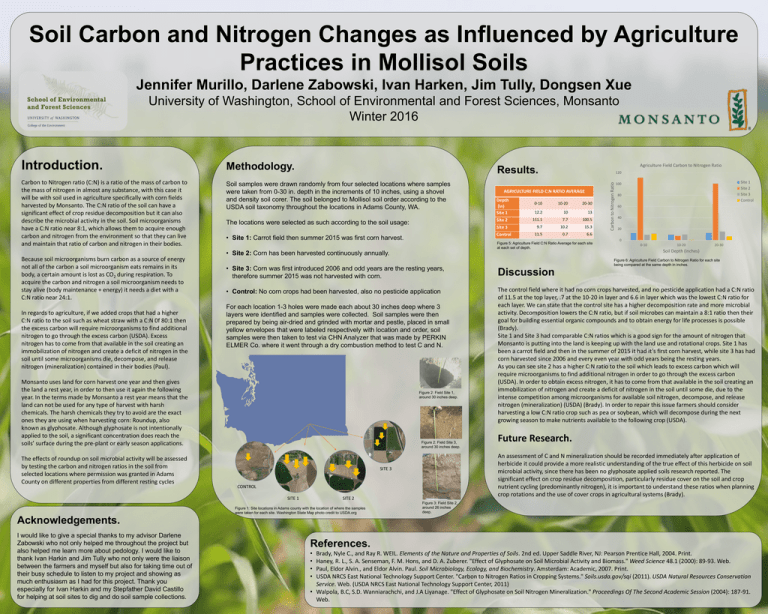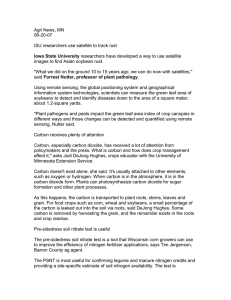
Soil Carbon and Nitrogen Changes as Influenced by Agriculture
Practices in Mollisol Soils
Jennifer Murillo, Darlene Zabowski, Ivan Harken, Jim Tully, Dongsen Xue
University of Washington, School of Environmental and Forest Sciences, Monsanto
Winter 2016
Introduction.
Methodology.
Carbon to Nitrogen ratio (C:N) is a ratio of the mass of carbon to
the mass of nitrogen in almost any substance, with this case it
will be with soil used in agriculture specifically with corn fields
harvested by Monsanto. The C:N ratio of the soil can have a
significant effect of crop residue decomposition but it can also
describe the microbial activity in the soil. Soil microorganisms
have a C:N ratio near 8:1, which allows them to acquire enough
carbon and nitrogen from the environment so that they can live
and maintain that ratio of carbon and nitrogen in their bodies.
Soil samples were drawn randomly from four selected locations where samples
were taken from 0-30 in. depth in the increments of 10 inches, using a shovel
and density soil corer. The soil belonged to Mollisol soil order according to the
USDA soil taxonomy throughout the locations in Adams County, WA.
Because soil microorganisms burn carbon as a source of energy
not all of the carbon a soil microorganism eats remains in its
body, a certain amount is lost as CO2 during respiration. To
acquire the carbon and nitrogen a soil microorganism needs to
stay alive (body maintenance + energy) it needs a diet with a
C:N ratio near 24:1.
In regards to agriculture, if we added crops that had a higher
C:N ratio to the soil such as wheat straw with a C:N 0f 80:1 then
the excess carbon will require microorganisms to find additional
nitrogen to go through the excess carbon (USDA). Excess
nitrogen has to come from that available in the soil creating an
immobilization of nitrogen and create a deficit of nitrogen in the
soil until some microorganisms die, decompose, and release
nitrogen (mineralization) contained in their bodies (Paul).
Results.
AGRICULTURE FIELD C:N RATIO AVERAGE
Depth
(in)
Site 1
0-10
10-20
20-30
12.2
10
13
Site 2
111.1
7.7
100.5
Site 3
9.7
10.2
15.3
11.5
0.7
6.6
Control
• Site 1: Carrot field then summer 2015 was first corn harvest.
120
Figure 5: Agriculture Field C:N Ratio Average for each site
at each set of depth.
• Site 2: Corn has been harvested continuously annually.
Carbon to Nitrogen Ratio
The locations were selected as such according to the soil usage:
Site 1
Site 2
Site 3
Control
100
80
60
40
20
0
0-10
10-20
20-30
Soil Depth (inches)
Figure 6: Agriculture Field Carbon to Nitrogen Ratio for each site
being compared at the same depth in inches.
• Site 3: Corn was first introduced 2006 and odd years are the resting years,
therefore summer 2015 was not harvested with corn.
Discussion
• Control: No corn crops had been harvested, also no pesticide application
The control field where it had no corn crops harvested, and no pesticide application had a C:N ratio
of 11.5 at the top layer, .7 at the 10-20 in layer and 6.6 in layer which was the lowest C:N ratio for
each layer. We can state that the control site has a higher decomposition rate and more microbial
activity. Decomposition lowers the C:N ratio, but if soil microbes can maintain a 8:1 ratio then their
goal for building essential organic compounds and to obtain energy for life processes is possible
(Brady).
Site 1 and Site 3 had comparable C:N ratios which is a good sign for the amount of nitrogen that
Monsanto is putting into the land is keeping up with the land use and rotational crops. Site 1 has
been a carrot field and then in the summer of 2015 it had it’s first corn harvest, while site 3 has had
corn harvested since 2006 and every even year with odd years being the resting years.
As you can see site 2 has a higher C:N ratio to the soil which leads to excess carbon which will
require microorganisms to find additional nitrogen in order to go through the excess carbon
(USDA). In order to obtain excess nitrogen, it has to come from that available in the soil creating an
immobilization of nitrogen and create a deficit of nitrogen in the soil until some die, due to the
intense competition among microorganisms for available soil nitrogen, decompose, and release
nitrogen (mineralization) (USDA) (Brady). In order to repair this issue farmers should consider
harvesting a low C:N ratio crop such as pea or soybean, which will decompose during the next
growing season to make nutrients available to the following crop (USDA).
For each location 1-3 holes were made each about 30 inches deep where 3
layers were identified and samples were collected. Soil samples were then
prepared by being air-dried and grinded with mortar and pestle, placed in small
yellow envelopes that were labeled respectively with location and order, soil
samples were then taken to test via CHN Analyzer that was made by PERKIN
ELMER Co. where it went through a dry combustion method to test C and N.
Monsanto uses land for corn harvest one year and then gives
the land a rest year, in order to then use it again the following
year. In the terms made by Monsanto a rest year means that the
land can not be used for any type of harvest with harsh
chemicals. The harsh chemicals they try to avoid are the exact
ones they are using when harvesting corn: Roundup, also
known as glyphosate. Although glyphosate is not intentionally
applied to the soil, a significant concentration does reach the
soils’ surface during the pre-plant or early season applications.
The effects of roundup on soil microbial activity will be assessed
by testing the carbon and nitrogen ratios in the soil from
selected locations where permission was granted in Adams
County on different properties from different resting cycles.
Agriculture Field Carbon to Nitrogen Ratio
Figure 2: Field Site 1,
around 30 inches deep.
Figure 2: Field Site 3,
around 30 inches deep.
An assessment of C and N mineralization should be recorded immediately after application of
herbicide it could provide a more realistic understanding of the true effect of this herbicide on soil
microbial activity, since there has been no glyphosate applied soils research reported. The
significant effect on crop residue decomposition, particularly residue cover on the soil and crop
nutrient cycling (predominantly nitrogen), it is important to understand these ratios when planning
crop rotations and the use of cover crops in agricultural systems (Brady).
SITE 3
CONTROL
SITE 1
SITE 2
Figure 1: Site locations in Adams county with the location of where the samples
were taken for each site. Washington State Map photo credit to USDA.org
Future Research.
Figure 3: Field Site 2,
around 26 inches
deep.
Acknowledgements.
I would like to give a special thanks to my advisor Darlene
Zabowski who not only helped me throughout the project but
also helped me learn more about pedology. I would like to
thank Ivan Harkin and Jim Tully who not only were the liaison
between the farmers and myself but also for taking time out of
their busy schedule to listen to my project and showing as
much enthusiasm as I had for this project. Thank you
especially for Ivan Harkin and my Stepfather David Castillo
for helping at soil sites to dig and do soil sample collections.
References.
•
•
•
•
Brady, Nyle C., and Ray R. WEIL. Elements of the Nature and Properties of Soils. 2nd ed. Upper Saddle River, NJ: Pearson Prentice Hall, 2004. Print.
Haney, R. L., S. A. Senseman, F. M. Hons, and D. A. Zuberer. "Effect of Glyphosate on Soil Microbial Activity and Biomass." Weed Science 48.1 (2000): 89-93. Web.
Paul, Eldor Alvin., and Eldor Alvin. Paul. Soil Microbiology, Ecology, and Biochemistry. Amsterdam: Academic, 2007. Print.
USDA NRCS East National Technology Support Center. "Carbon to Nitrogen Ratios in Cropping Systems." Soils.usda.gov/sqi (2011). USDA Natural Resources Conservation
Service. Web. (USDA NRCS East National Technology Support Center, 2011)
• Walpola, B.C, S.D. Wanniarachchi, and J.A Liyanage. "Effect of Glyphosate on Soil Nitrogen Mineralization." Proceedings Of The Second Academic Session (2004): 187-91.
Web.






